This fly is unbelievably small! It was tied by me for Dutch Hans Weilenmann’s project SFP or Smallest Fly Page. The pattern was tied once in 1998 – and probably won't be again!
This story hails from late 1998 and early 1999 where Dutch Hans Weilenmann sent out a bunch of hooks to tyers all over the world and asked them to tie a fly on it.
Hans W
Hans used to be a very active as a fly tyer at shows, in magazines, and on the web in various forums, but has disappeared from the fly tying community and been silent with regards to flies and fishing for several years.
He's still around, and you can find him on Instagram where he posts a lot of beautiful bird and nature photos.
Back in the day, Hans maintained a web site called Flytier's Page, and it so happened that that page wound up on a server, which I maintained – and still maintain. The site is still around, but hasn't been updated for a long time.
Since I have access behind the scenes, I nosed around a bit, and happened to find the stub for a page with series of flies entitled SFP or “Smallest Fly Page”.
The files for this page included photos of a lot of the flies that Hans got back from the tyers and also various texts that they sent and records that Hans made.
The Smallest Fly Page
So the purpose of SFP was to make a fly gallery online and the job for those of us who got a hook was to tie a fly for said gallery.
Now, this might seem like a fairly normal assignment for a number of tyers: tying a fly on the same hook and sending the finished flies back to Hans for him to make an online gallery with them.
The thing was just that the hook was a size 32! Yes, thirty two! And even a very small size 32, namely the Mustad model 277, which is probably the smallest hook ever made commercially.
On the box it said:
O. MUSTAD & SÖN
Manufacturers
Oslo Norway
Qual. 277
Hollow Point
Mustad-Crystal Hooks
Flatted Goldplated
100
No.32
You-won't-believe-how-small
The hook really is very small, like in you-won't-believe-how-small. My crude measurements from the few pictures I have is that the hook length (yes, the full hook!) is about 2 millimeters, which is about 0.075 inches or close to 1/16 of an inch if you prefer fractions. The gap is probably about 1 millimeter or a bit more than 1/32 inches. So that's one small hook!
The hook is spade “eyed”, meaning that it has no ring eye, but is smashed flat where the eye usually sits, and it's then snelled on the leader. The hook is also gold plated, and as far as my research tells me, with 24 carat gold!
Nick Runarsson
In good company
As far as I can see from Hans' records, he sent out at least 117 hooks. The records list all names, and is a veritable Rolodex of fly tying and fly fishing notabilities. I feel pretty humbled being on that list, since my skills hardly match the far majority of the tyers on there – and back then they definitely didn't!
Just a few for the sake of name dropping:
Theo Bakelaar
Gretchen and Al Beatty
Jason Borger
Oliver Edwards
Hans van Klinken
Paul Marriner
Marvin Nolte
Paul Slaney
… and many more.
You will also find Lawrence Waldron of LAW vise fame on the list, and my fellow GFF'ers Bob Petti and Steve Schweitzer are also there.
So altogether a hundred plus very proficient fly tyers … and then me.
Hooks broken and missing in action
The records also have dates for when the hooks were sent and when the flies arrived. It shows which pattern people tied, and it also mentions several tyers who reported that their hook broke or LDR'ed – in other words disappeared.
Quite a few didn't return a fly at all, it seems, but still, Hans managed to photograph about 75 flies.
The patterns are as impressive as the tyer names, and includes a Comparadun, a Royal Coachman, a Rusty Rat and even a Green Highlander, the last one tied by Marvin Nolte of course! Let me say – with all due respect for Marvin – the fly in the picture bears very little resemblance to a Green Highlander, which isn't surprising. In all honesty, most of the flies are pretty far from true to their original patterns where one exists. But just doing a Comparadun, a BWO or a parachute fly on an extremely small #32 hook deserves all the credit one can give!
Heck, Welsh Paul Slaney even tied what looks like a Falkus Lure, using an extra size 32 hook as a trailing hook!
In connection with my own fly – the Needle Shrimp – Hans conveniently included the mail I sent him when sending of the fly, and that text can be read here:
My fly
The Needle Shrimp #32
This is the full and truthful story of the creation of The Needle Shrimp, size 32.
When the letter with hook and instructions arrived, it contained a small heap of broken plastic, and my life immediately passed by my eyes in a rush. I thought Hans had put the hook in a small veil, which had broken on the way leaving the hook astray in the corners of that humongous envelope.
I was calmer after having read the letter and seen the small white patch of paper which allegedly hid the hook. I let a lamp shine its light through the letter, and true enough - as small as a hair; there was a hook behind that small piece of paper.
I decided to put the letter aside and take up the task of tying the fly later.
I had already decided on a pattern.
Having just published an article on a small shrimp pattern - The Match Shrimp - I would tie an even smaller but similar shrimp prematurely baptized The Needle Shrimp.
Postponing the time of my showdown proved to be a good decision, because reports of ballistic size 32 hooks were numerous, and there was some good advice on handling the small hook during the following days.
Holy Guacamole!
That was one small hook!
One late evening after a small Christmas party at work, which included consumption of alcoholic beverages, I felt ready.
My happy and slightly exuberant state of mind was perfect for handling extremely small hooks. Also my smallest son had just bought a pair of tweezers with built in magnifiers. Great for the purpose thought I, and cleared the tying table.
Fully well knowing that there was a potential danger of a hook going into living room orbit, I put a large piece of white paper under my vice. I also prepared a small piece of tying thread to tie on the hook as soon as I removed it from its hideout behind the small tab.
I poured a glass of single malt - kindly left by a Dutch fly fishing friend who had visited recently - and started peeling off the small paper.
Holy Guacamole!
That was one small hook!
It stuck to the back of the small tab, and I thought it best to get out my son's magnifying tweezers.
As I carefully grabbed the hook to put it on the paper, it did what I had feared most: LDR'ed.
With a small ping it went off into what I thought was oblivion. My happy state of mind changed in that moment as I overlooked the tying table and the floor, realizing that I wouldn't stand a chance of ever finding it.
To my surprise and joy it hadn't gone far.
It was lying right there in front of me on my safety paper, less than 20 centimeters or 8 small inches from the vice.
I took a sip and prepared for the next step: getting a piece of tying thread on the hook as yet another safety precaution. A combination of a dubbing needle and the magnifier on the tweezers were used as tools to maneuver the hook and thread and finally I had it lassoed.
The next step was getting the hook into the vice without crushing it. I have a vice with an amazing holding power, and I have crushed hooks larger than this one ... actually I have only tied on hooks larger than this one, but that's a whole other story.
I opted for the standard orientation in the vice as opposed to reverse with the spade head into the jaws.
I thought that knowing the fragility of the hook gave me an advantage. I knew I had to be careful while tying. The mounting went fine, and the hook was securely fastened in the vice with the lasso attached to the vice. It sat there, but certainly didn't leave much space.
So I went on to preparing a tying thread. Now, an 8/0 is like an anchor rope when you tie it in on this hook. I had some Bennichi GSP, which lies somewhere between 10/0 and 12/0, but even that seemed thick. The Bennichi is stranded, so it's possible to split it.
As I anticipated that this fly would need about 10-20 turns of thread, I found it suitable to split about 15 centimeters or 7 inches.
I let the thread sit in a bobbin holder and used that carefully all through the process.
The pattern I intended to tie is a simple shrimp, usually called the Match Shrimp because it's as small as a match. For that I use thin monofilament for the eyes. Now thin would be like 2X or 3X for a size 10 or 12 hook.
Having converted the fly to a Needle Shrimp on a size 32 hook meant really, really thin.
Going through my stock I found some 8X - that's 1 lb. test - that I had borrowed from a US friend on some trip and conveniently forgotten to return.
Imagine melting 8X with a lighter in order to create a small terminal lump.
That's close to impossible.
Any flame close to an 8X tag will mean fire. Poof!
One more sip made my hands steady, and I actually succeeded in making a small set of eyes. I colored them black and was ready to tie them in.
So here I have a hook and a set of eyes which together have a smaller diameter than most hooks I usually tie on. The thread I'm supposed to tie them together with is thinner than the frays from an ordinary 8/0 thread.
Well, I really don't remember how I did it, but within ten minutes or so, I managed to get the eyes to sit on top of the hook. I immediately added the smallest drop of varnish in this universe, and left the thing to dry.
My next point on the agenda was the tail - or rather the antennae. These are normally made from a small bunch of rabbit hairs, and why change that? Rabbit hairs are thin, and just using a small enough bunch should do the trick.
But do you have any idea how small 'a small enough bunch' is for a size 32 fly?
It's small ... like in microscopic.
I cut off a small bunch from my trusty rabbit skin and removed all the longest guard hairs and the underfur. Well, I trashed that and tried again.
Cut a smaller bunch, removed a bit more guard hairs and a bit more underfur. Trash again.
This proved far from trivial, but I ended up with less that half a dozen of the thinnest rabbit hairs and managed to get them to sit over and between the eyes.
Ready for the next step: dubbing the body. This would also be done with rabbit, and having learned from the tail experience, I used extremely little material lightly plucked from an area of the skin that was almost clean shaved. The fine underfur proved excellent for the job and easy to apply. Three or four turns of very thin dubbing left the hook covered, and I could remove the surplus, take an extra turn or two and get ready whip finish.
Well knowing that too much stress on the hook in combination with its fragility would make my manual whip finish a risky affair, I decided to make a couple of half hitches in stead.
These were easily done over the spade eye of the hook, and I could cut the thread with my Squizzers.
Snip! I was done!
The last step was to add a tiny drop of varnish over the half hitches without smearing the whole fly in varnish.
Whether it was the single malt, my excitement after my previous success or just sheer luck I don't know, but it seems that there was varnish on the half hitches and only on the half hitches when I was ready to remove the hook from the vice.
As I had lassoed the hook, and attached the lasso to the vice I wasn't particularly nervous before that operation. No matter where the hook would jump, the 8/0 ankle chain would hold it down. And as expected the finished fly was hanging at the end of its string as I released it.
A closer inspection through the magnifier revealed a small but acceptable fly. I transferred it to a small plastic container - sent by another Dutch friend and since emptied for the fly it had contained.
The fly was ready for shipment.
Needle Shrimp
Hook: Very small, size 32 is suitable, but hard to obtain
Thread: As thin a strand of split GSP as you can make
Eyes: 8X mono melted and dyed black with a marker
Antennae (tail): Very few thin natural rabbit hairs one time shank length
Body: Rabbit underfur dubbing, sparse ... very sparse
Martin Joergensen, Copenhagen, Denmark mailto:martinj@login.dknet.dk (This mail is long gone. It's now: martin@globalflyfisher.com)
Hans himself tied a Rusty Rat, and as a submission for the International Pattern Swap in 1999 - also known as IPS 3 - he created an entry on the fly and the whole project, which went somewhat like this:
Hans' own fly
The Rusty Rat #32
It all started with a Walton's Thumb!
Lister Stephen DiCerbo posted a request for info on where to locate this tool. (For those not familiar with a Walton's Thumb, it is basically a Swiss Army knife kinda tool, but designed for flyfishers. Put on the market some twenty-odd years ago. Quality tool made from stainless steel, very well made, pretty pricey, and way too heavy for vest use IMO. Still not sure why I ever bought one. Never did do more with it than fondle/admire/pack away...)
Anyway, I'm drifting... I told Stephen I'd try to find my own Walton's Thumb back and we'd talk ;-)
Turned house upside down, inside out looking for it. Never did find it back. But guess what ;-)
Hang on... what have we got here... Yes!!!
Some twenty years ago Mustad produced a batch of rather small hooks. And this batch coincided with me “hungering” for different types and sizes of hooks, one box found its way from the shop to my growing hook collection. Tied a half dozen flies on them. Just to see if I could. Then ‘filed' the box.
Fast-forward time... now twenty years, and four house moves later...
Thorough search of my stashes of tying and fishing stuff, looking for the never-ever-used Walton's Thumb. Without success. Although...
Looka here... my long lost, all but forgotten about box of #32 hooks!!! *major smile*
Gee-wiz... they are even smaller than I remembered!
Uh... okay... now I have some ninety #32 hooks... what to do with them. No way will I be tying ninety of them wee flies...
Put my thinking cap on and after a while it dawned on me... ;-)
Let's ask some friend-tiers if they are game for the Smallest Fly Page ever!
Now who do I hate most... only kidding!
Emails were sent around the globe and frankly I was amazed at the response. Almost to the last person everybody asked jumped on board quite eagerly. But then... hardly anybody had an idea how small these hooks really were. “Hey, I've tied a bunch of #26 flies last week... send on that hook...”Fighting talk! Flytiers... you gotta love ‘m... ;-)))
Won't bore you with the logistical nightmares of getting the hooks to the tiers, the non-logistical nightmares experienced around the world when the actual hooks were seen (or not seen, as often the case), the inventive language unleashed after the hooks decided to do a long distance release right out of the vise and never to be seen again. The lucky ones suffered LDR before they tied their fly. The unlucky ones experienced the LDR, or hook snaps, as they were finishing off their masterpiece...
One comment which came back is such a classic I have to share it with you:
“Hans, thanks very much for inviting me to participate in the SFP. It was an experience I will never forget. Please do not ever ask me again...”
For the full story, told in their own words, please turn your browser to the SFP Sampler on http://www.danica.com/flytier/sfp_preview/sfp_preview.htm (Martin's note: this page doesn't exist anymore, but I'm working on a page with all Hans' SFP-images)
The Walton's Thumb? Nope, never did find it.
For my own entry to the SFP I selected a Rusty Rat, an atlantic salmon pattern. I figured with making a few substitutions for the materials I might come up with a passing ‘Rat'.
Rusty Rat
Hook: Mustad Model 277 #32
Thread: 2 strands of white GSP thread
Tail: Two tips of pheasant herl
Abdomen: Yellow Pearsall Naples silk (one strand split off twisted 4-ply)
Thorax: Mole, dyed olive in picric acid
Wing: Pine squirrel belly guard hair
Collar: Single barbule from the base of a grizzly hackle
References
Some articles on small hooks and the Mustad 277 in particular.
- Swedish Niclas Runarsson's article on small flies and the Mustad #32. Some of the images in this article were kindly put at my disposal by Nick.
- Here's an article from ReelFlies from 2014 about the hook.
- This one is by Ed Mitchell, US angler and author.
- This one is from 2012 and the site Small Fly Funk run by Andy Baird, who was also equipped with a hook by Hans.
- This one from Swedish Mats Olsson about a Jassid tied on the Mustad hook.
- And this last one - also from 2012 by Mats Olsson - is found on his site Tying and Fishing Tiny Flies, and compares several small hooks.
Hand picked for this article
- Log in to post comments

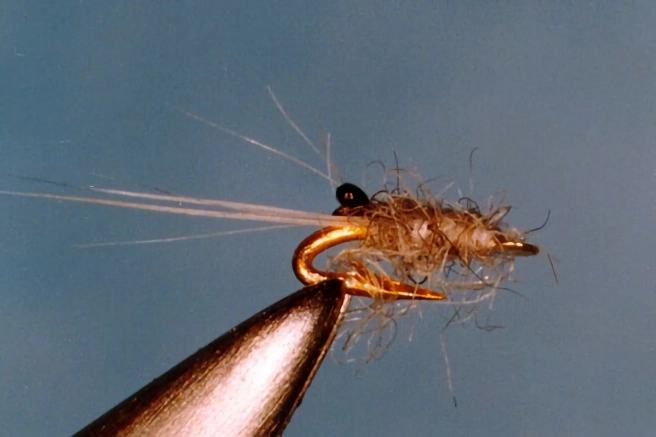
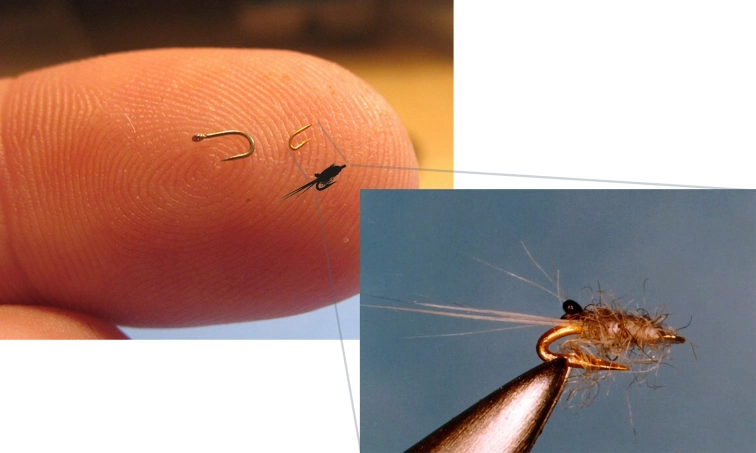
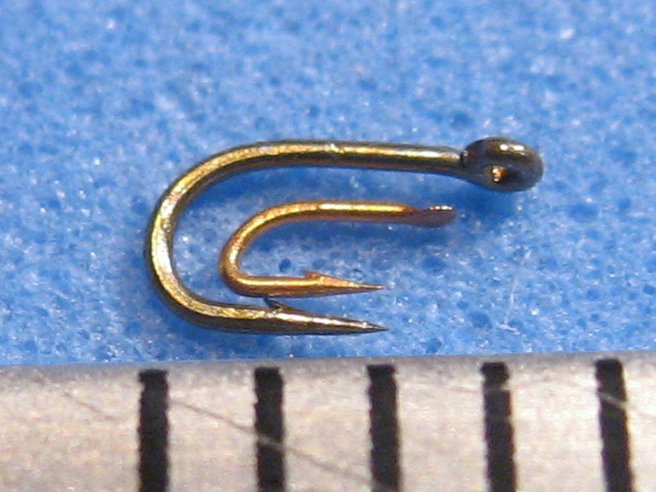

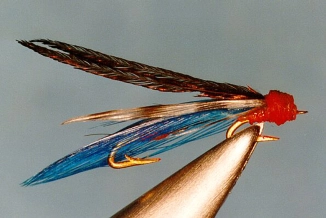
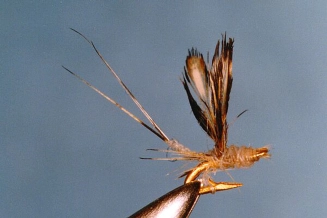
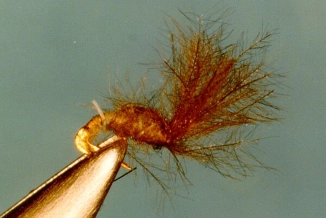
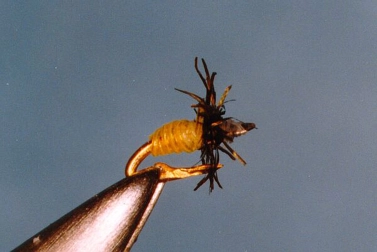
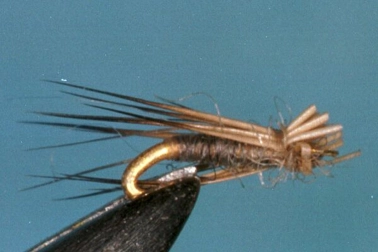
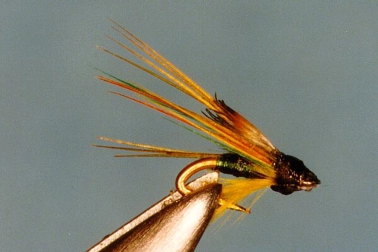
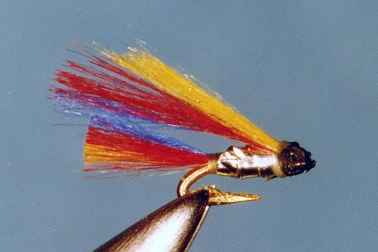
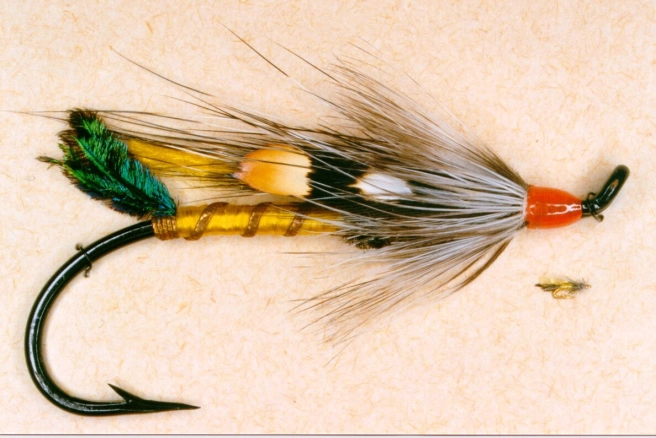
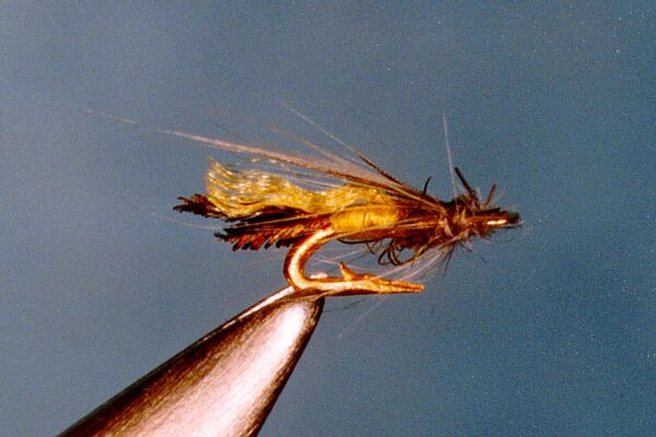


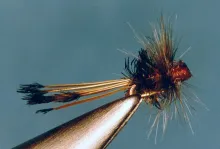
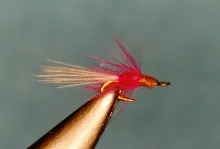


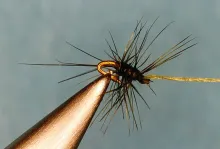

Small and Smaler Photo
Just wondering in the small and smaller photo what the other hook is in that photo?
Thanks!
Tiemco TMC 518
Jill,
It's a Tiemco TMC 518, also size 32, as you can see by clicking on the image to see a larger version.
Martin